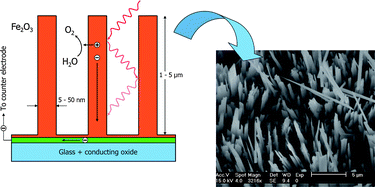The direct conversion of solar energy into hydrogen represents an attractive but challenging alternative for photo-voltaic solar cells. Several metal oxide semiconductors are able to split water into hydrogen and oxygen upon illumination, but the efficiencies are still (too) low. The operating principles of photo-electrochemical devices for water splitting, their main bottlenecks, and the various device concepts will be reviewed. Materials properties play a key role, and the advantages and pitfalls of the use of interfacial layers and dopants will be discussed. Special attention will be given to recent progress made in the synthesis of nanostructured metal oxides with high aspect ratios, such as nanowire arrays, which offers new opportunities to develop efficient photo-active materials for solar water splitting.
You have access to this article
 Please wait while we load your content...
Something went wrong. Try again?
Please wait while we load your content...
Something went wrong. Try again?


 Please wait while we load your content...
Please wait while we load your content...